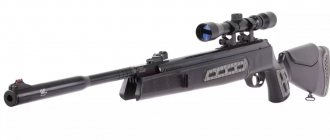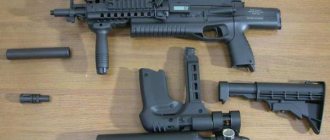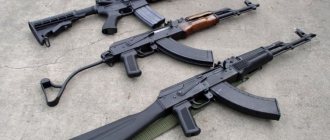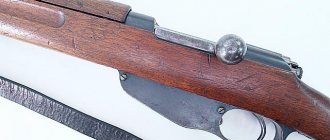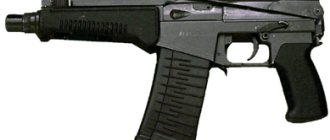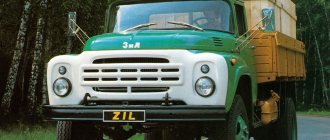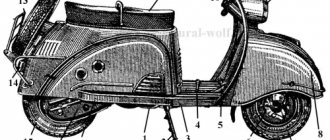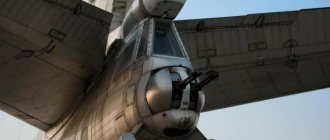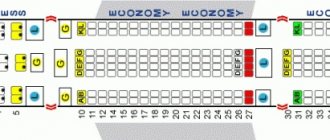Description Marlin 1895
A carbine with a lever - Lever Action - reloading method. A large-caliber weapon chambered for the 45-70 Government (11.6 mm) centerfire cartridge, the bullet of which has enormous stopping power.
The magazine is tubular, under-barrel. Ejection of the cartridge case through the window on the side (right) side of the receiver. Optical sights can be installed.
This video will tell you what Marlin 1895 is and how to handle it:
Advantages and disadvantages
Time-tested design. An authentic carbine from the time of the exploration of the Wild West, which determined its popularity in the USA, where there is a cult of cowboy romance.
- The Henry Brace allows the weapon to be reloaded at speeds that approximate semi-automatics. Coupled with the enormous stopping power of the .45-70 Government bullet, it makes it indispensable when hunting particularly large game in impenetrable thickets, where you can come face to face with a huge bear or wild boar, and you will have to shoot a lot and quickly.
- The abundance of moving parts and hinges in the reloading mechanism makes, from a theoretical point of view, a weapon less reliable than a bolt-action rifle. In practice, the Henry clamp is a lever that can pull out any stuck cartridge case and overcome the resistance of the “evil” dirt. If you take care of the weapon, it will work flawlessly. Moreover, the carbine mechanism was originally designed to fire black powder, leaving a huge amount of soot on all parts.
- Some concern is caused by the location of the cartridge from the central strike in the tubular magazine. Despite the fact that the bullet has a blunt-pointed shape, it cannot be ruled out that the primer will be punctured and the ammunition will explode during falls and impacts.
.45-70 Government cartridges are not very common in Russia and are expensive.
- The external trigger allows you to effectively monitor the condition of the weapon and assess its readiness to fire. If necessary, you can decock the firing pin and be completely safe even with a cartridge in the chamber during long marches. The design of the bolt will not allow it to fire unless it is fully closed.
- The Henry brace does not allow, or makes it inconvenient, shooting from a rest position. This design feature in the past led to the fact that weapons with it were no longer used in the army.
- The absence of protruding parts - bolt handles or bolt frame - makes this weapon convenient for transportation in a saddle holster. This is why it is popular with cowboys, who usually ride on horseback.
Photo Marlin 1895 SBL 45-70
Purpose
This is a weapon for hunting big game - elk, deer, wild boar and bears - in thickets when the shooting distance is short.
Varieties
- Model 1895 is the basic one, the barrel is 56 cm long. It has a semi-pistol stock made of American walnut wood, a magazine with a capacity of 4 rounds, and the metal parts are blued.
- Model 1895CB - long (66 cm) hex barrel, magazine capacity of 9 rounds. The stock is straight, English, made of American walnut wood.
- Model 1895CBA - short (47 cm) hex barrel, magazine capacity of 6 rounds. The stock is walnut, straight English.
- Model 1895G - short (47 cm) round blued barrel. Magazine capacity of 4 rounds. The stock is straight English, made of dark American walnut.
- Model 1895GBL – barrel like the previous model, 6-round magazine, enlarged shackle ring. The stock is semi-pistol, laminated, brown.
- Model 1895GS - same short barrel, 4-round magazine, all metal parts made of uncoated chrome-molybdenum steel. The stock is straight English, made of dark American walnut wood.
- Model 1895GSBL – barrel length 47 cm, round, blued, magazine for 6 rounds. Oversized bracket. The stock is semi-pistol, laminated, green.
- Model 1895SBL - the same length, but with a stainless steel barrel. Magazine for 6 rounds. The receiver has a long (up to half the barrel) Weaver rail. The stock is semi-pistol, laminated, dark gray.
Air rifles of 4.5 mm caliber: the agony of choice
Small-caliber pneumatic weapons (4.5 mm), due to the absence of the need for their registration, obtaining permits and widespread, widespread sale, are the most popular and in demand in Russia. In addition, the affordable price of pneumatics (compared to pneumatic weapons of larger calibers and firearms for hunting) is a big plus in the piggy bank of this weapon.
When choosing a pneumatic gun for yourself, every potential owner wants to get a copy with maximum power and rate of fire. Do you need these characteristics? Let's figure it out and give some advice to novice owners of pneumatics, in particular air rifles.
Before making a purchase, you should decide on such important points as the purpose of the product being purchased, priority requirements, type, and budget. If you plan to hunt with an air rifle, you will really need a fairly powerful model. If the main purpose of the weapon you are purchasing is recreational shooting in the countryside or at a shooting range, then it will be quite enough to buy a rifle of low power, but with high shooting accuracy and an impressive appearance. If you need pneumatics for sports, you need to choose a product from the category of specific sports models, with high ergonomics and very accurate shooting. And finally, if you are a collector, then the main, priority characteristics of an air gun for you are the exterior, execution, circulation (that is, the rarity of the product), and possibly authenticity to the firearm prototype.
For recreational shooting, you will only need to purchase an inexpensive modern rifle from IzhMech
– model
МР-512С-00
. For a small amount of money you will get a spring-piston rifle, the so-called “fracture”, that shoots lead bullets. The bullets cost mere pennies, the mechanism and barrel of the rifle are made of steel (will last a long time), and the energy of the bullet is enough to “deal” with tin cans.
If you want something more advanced, check out the Crosman
525X Recruit
. This model is somewhat more powerful than the product from the Izhevsk plant, it does not require reloading after each shot (compression, multi-compression principle and the presence of a magazine for five charges), and is also equipped with an optical sight (included in the delivery package). Such a rifle will delight you and your guests with entertaining shooting for many years. Let us add that with such a rifle you can quite successfully hunt rodent pests and even crows. Note that multi-compression rifles have low recoil and a quiet shot sound, which are also important factors for shooting, especially when hunting.
Let's move on to powerful models that are optimal for hunting. We recommend taking a closer look at the G-Force 15
from
GAMO
. This spring-piston rifle develops a starting speed of about 305 m/s for a standard lead bullet, which is quite enough to confidently kill game even at a considerable distance. In addition, this model has a spectacular appearance (stylized as the legendary American Armalite AR-15 rifle). Therefore, it may also be of interest to collectors.
Those who prefer cocking the pneumatic mainspring using an under-barrel lever will like the BIG Cat CF- S
, which has similar
G- Force 15
.
For connoisseurs of classic rifle design, GAMO offers the BIG Cat 1250
, equipped with an optical sight.
the Hatsan-125 pneumatic spring-piston rifles
and
Crosman TR 77 NP
. Both of these rifles are capable of accelerating a lead bullet to a speed of 300 m/s. Do you need even higher bullet speed? Most likely no. There are known cases when small-caliber pneumatics firing lead bullets with a starting speed of about 200 m/s were successful in hunting foxes and even wild boars weighing about 100 kg. After all, what is decisive is not the speed or the number of Joules that a bullet “brings” when it hits a trophy, but the place where it hits. According to verified data, a hare hit in the temple by a 4.5 mm bullet from a distance of 20 meters became a trophy. The fox mentioned above was shot from fifteen meters in the carcass behind the front paw. And so on, many examples can be given.
Of course, powerful multi-compression models and pre-inflated air rifles ( PCP)
).
Just keep in mind that the cost of such weapons is several times higher than the price of powerful spring-piston models. This is especially true for PCP rifles. The price for such products with a decent starting bullet speed (from 300 m/s) starts from 25-28 thousand rubles, and the average cost of PCP rifles exceeds 50 thousand rubles. Therefore, it is worth thinking carefully and deciding what you are betting on: on a single accurate shot from an inexpensive and powerful spring-piston rifle or on a relatively silent, but expensive PCP model, from which you can shoot a trophy several times in a couple of seconds. PCP rifles are produced by Ataman
,
Hatsan
,
Umarex
.
As for sport shooting with air rifles, PCP models are also leaders in this segment. And special sports products do not have a “humane” price tag. Walter sports air rifle
“is 1500-2500 euros, that is, 110-170 thousand rubles.
This price is explained by the highest quality of workmanship, a lot of adjustments, adjustments, ergonomics and excellent balance of each product. At the same time, we note that the starting speed of a bullet in sporting PCP rifles does not go beyond 200 m/s - this is simply not required. Walther
delusions,
Fienwerkbau
and
Steyr
are very popular among athletes . Of course, novice athletes can use cheaper air rifles for training and competitions - compression and even spring-piston ones. But high results require significant costs, and as the class gains, the transition to PCP models is simply inevitable.
Collecting air rifles is a topic too broad to be covered in one article. We only note that this category includes rare and one-off items, products discontinued and produced in small batches, as well as models that imitate the appearance of military firearms with high accuracy. The latter, for example, includes the Crosman M-4-177
, copying the American M-4 automatic carbine.
In this version, the pneumatic gun fires shots using gas energy (CO2 canister) and shoots BB balls. Naturally, not a high starting speed. This model does not have excellent shooting accuracy. Umarex Walther Lever Action
rifle also has a remarkable design ; it is made in the style of the legendary classic “Winchester” with reloading with a trigger lever. This rifle shoots quite well, despite the fact that it uses the energy of compressed gas (CO2 cartridge). The rifle is loaded with lead bullets.
Also included in the collection of air rifles are legendary, very popular models that have an army of fans around the globe. Such models include the Crosman 2100
. They loved it for the ability to arbitrarily regulate the energy of a shot by the amount of pressure (pre-injection), autonomy (does not require CO2 cans or pumps), compactness and light weight, excellent balance, shooting accuracy and developed power. Experts also note the rifle’s good maintainability and comparative simplicity of design.
In conclusion, we note that collectible air rifles include both customized and homemade products of this class. For example, a homemade PCP rifle with a Henry “Wasp” brace, made by master Alexey RICCI.
Specifications
Marlin 1895
| Charging type | Lever Action |
| Caliber | .45-70 Government |
| Trunk | Round |
| Barrel length (mm) | 559 |
| Rifling | 6 right-hand deep-cut Ballard-type |
| Rifling pitch | 1:20” |
| Magazine capacity | 4 |
| Lodge | Semi-pistol, American walnut |
| Overall Length (mm) | 1029 |
| Weight without cartridges (kg) | 3,4 |
Marlin 1895CB
| Charging type | Lever Action |
| Caliber | .45-70 Government |
| Trunk | Hexagonal |
| Barrel length (mm) | 660 |
| Rifling | 6 right-hand deep-cut Ballard-type |
| Rifling pitch | 1:20” |
| Magazine capacity | 9 |
| Lodge | Straight English, American walnut |
| Overall Length (mm) | 1130 |
| Weight without cartridges (kg) | 3,8 |
Design
The Marlin 1895 is a rifle with a tubular under-barrel magazine that is reloaded with a Henry Lever Action.
- The barrel is thick-walled, caliber .45-70 Government. There are hexagonal models. Six deep trapezoidal Ballard rifling.
- The receiver is closed, on the right plane there are two windows - for ejecting cartridges and a magazine hopper, covered with a spring-loaded curtain. The top edge is flat, it has two holes with metric threads for installing optical sights.
- The bolt is round, with one extractor tooth and a flat cylinder mirror. Locking is done with a wedge that fits into a rectangular groove located on the underside of the stem, closer to the shank of the striker. During locking, the firing pin parts are closed, so a shot is possible only if the bolt closes the breech completely.
- The trigger mechanism is cocked by a lever connected to a Henry clip. The hammer can be cocked or released manually to the so-called half-cocked position, when a gap of several millimeters remains between it and the shank of the firing pin, which does not allow the shot to be fired.
- The firing pin does not have a spring and moves freely along the channel in the bolt stem, therefore, if the trigger rests against it and there is a cartridge in the chamber, the primer can be punctured and fired. This case is specifically discussed in the instructions, which require that the shooter control the position of the trigger and be sure to put it half-cocked if for any reason it is in the extreme forward position.
- To mechanically lock the trigger, there is a safety catch, the flag of which is shaped like a button located above the trigger guard, near the butt plate of the receiver. It turns off by moving the button to the left, after which a red ring mark appears on the pin.
- The set of sighting devices consists of a rear sight adjustable vertically and horizontally and a metal front sight in a cylindrical casing.
- Wood stock - solid walnut or laminated. One half of the models is equipped with a semi-pistol stock, the other with a straight English stock. The stock has a straight comb inclined to the axis of the barrel. A shock-absorbing butt pad is installed.
Automatic rifle project H.S. Maxima
The machine gun, designed by engineer Hiram Stevens Maxim, seriously changed the situation on the battlefield. The American-British inventor managed to successfully solve the problem of creating fully automatic weapons that do not require an external source of energy. It should be noted that the machine gun did not appear immediately. Work towards the creation of automatic weapons by H.S. Maxim started with several other projects, including an option to modernize an existing model. With the help of several new units, the gunsmith managed to turn an existing model of small arms with manual reloading into an automatic rifle capable of firing bursts.
H.S. Maxim became fully involved in the subject of small arms in 1881, after moving from the USA to the UK. Until this time, he managed to develop several weapons-related projects, but they did not reach full practical implementation. In the early eighties, the designer proposed another version of the system, capable of independently reloading weapons. This development was later patented. American patent number US297278 was issued to the inventor in April 1884. The subject of the patent was defined as follows: “Mechanism for operating gun locks by recoil.”
According to one version, the idea of a “shutter control” system appeared after H.S. Maxim tried one of the 45-caliber rifles that existed at that time. Weapons with a sufficiently powerful cartridge had a corresponding recoil, which made shooting difficult and was actually not used at all. The talented inventor could not ignore the useless recoil and attempted to use it as an energy source for reloading weapons. The prospects for such a technical solution were obvious.
The Winchester M1873 rifle is a typical representative of the B.T. Henry. Photo: Wikimedia Commons
The basis for the new automatic weapon was to be one of the lever-action rifles from the Winchester Repeating Arms Company. In the sixties of the 19th century, this company began producing lever-action rifles with mechanisms designed by Christopher Spencer and Benjamin Tyler Henry. For various reasons, the design of B.T. Henry became more widespread and soon supplanted the competing system. The result of this was the appearance of several Winchester rifles, which are often referred to as Henry-Winchester systems.
Different Henry-Winchester rifles had different design features and used different ammunition, but had similar operating principles. Thus, under the long barrel of the weapon there was a tubular magazine with a spring for feeding cartridges. Inside the receiver were mechanisms for feeding a cartridge into the barrel, a movable bolt and levers for controlling these mechanisms. The system for extracting the spent cartridge case and feeding a new cartridge was connected to a large trigger safety guard (the so-called Henry guard). When the bracket was turned forward and down, the weapon was reloaded. In addition, the hammer was cocked at the same time. Having pulled the trigger and fired, the shooter had to move the guard again and reload the weapon.
H.S. Maxim proposed a set of special equipment and a principle for modifying existing weapons that made it possible to make them automatic. The new automation was supposed to work due to the recoil force of the shot. An interesting feature of the mechanisms used was the minimization of the necessary modifications to the weapon for the introduction of a new device. In addition, by changing the size and adjusting its individual parts, the “bolt control mechanism” could be used to modernize a wide variety of small arms equipped with a Henry bracket: from rifles to revolvers.
The rifle's own mechanisms had to undergo minimal changes. It was proposed to remove the existing bracket from the weapon for reloading. On its axis, located under the lower part of the receiver, a small lever with a hinge should be placed. A long arm remained inside the receiver, and a smaller part of the lever with a ring for connection with other parts protruded beyond it.
Internal mechanisms of a Henry system rifle. Photo: Wikimedia Commons
Also H.S. Maxim developed a new design for the safety bracket. Instead of a product with an open half-ring covering the trigger and a loop for holding with fingers, it was proposed to use a different part. In its front part, the safety bracket was kept open at the top, and the rear part was made in the form of an elongated rod with fastenings for other parts. There was a small protrusion at the rear of the trigger guard. Also in the inventor’s drawings there is another version of the bracket in the form of an elliptical part. In this case, instead of a short protrusion, a long hook was provided in the central part.
It was proposed to place the most complex units of the “control mechanism” inside the butt of the existing weapon. At an angle to the axis of the butt, but parallel to the axis of the barrel, a system with two springs, a rod and a lock was to be installed in the butt. To accommodate the necessary parts, a cylindrical through channel had to be drilled in the butt. In addition, above the cylindrical channel there was a narrow slot of complex configuration for installing other parts.
Inside the cylindrical channel H.S. Maxim placed a metal cylinder, held in position by a complex shaped support piece mounted on the bottom of the stock neck. In the middle of the cylinder there was a small slot for the removal of internal parts. In the rear volume of the cylinder there was a tube connected to a movable butt plate, which was responsible for reloading the weapon. In this case, there was an additional bushing in the front part of the tube, and a slot in its upper surface. With their help, the tube had to contact the front rod of the mechanism, the shank of which entered into the front part of the tube. There was another spring in the free volume of the buttplate tube. The head bushing of the butt plate tube had to interact with a spring placed at the front of the cylinder. The task of this spring was to return the mechanisms to their original position with the completion of the recharge cycle.
A rod was placed at the front of the cylinder with an extension at the rear, contacting a spring inside the butt plate tube. The head part of the rod, extending through the hole in the neck of the butt, received a hinge for connection with the trigger guard.
On the expanded part of the rod it was proposed to mount a stand with a roller, passing through the slot of the cylinder and extending into the upper slot of the butt. There was an L-shaped stop in front of the cylinder slot, and a leaf spring in front of the slot.
Scheme “Mechanism for operating gun locks by recoil” from the patent. On the left is the system in the neutral position, on the right - in the middle of the cycle, with the butt plate at maximum displacement
Above the tube, a specially shaped plate latch with a beveled upper front part and a tooth on the lower surface was hinged to the butt plate. A curved surface was provided behind the tooth to contact the roller on the post. The front part of the latch, when moved to the extreme forward position, had to contact the leaf spring.
Despite the apparent complexity of the design, “Mechanism for operating gun locks by recoil” designed by H.S. Maxim had a fairly simple principle of operation. If we describe the operation of this system in a simplified manner, then reloading the rifle should have been carried out due to the mutual displacement of the butt plate and other components of the weapon. At the same time, the internal parts of the new system had to perform several actions sequentially.
In preparation to fire, the shooter had to place cartridges in the magazine and cock the weapon by pulling the trigger and pressing the butt plate. After this, the rifle was ready to fire in automatic mode. Until the ammunition was completely used up, the shooter did not need to engage in operations to reload the weapon - all such tasks were assigned to automation.
When the trigger was pressed, the trigger was released, which, under the action of the mainspring, moved forward and hit the firing pin. The latter initiated the ignition of the cartridge charge, followed by a shot. The recoil impulse generated during the shot pushed the rifle back. At the same time, the buttplate of the butt, in contact with the shooter’s shoulder, had to remain motionless (in comparison with the rest of the rifle) and ensure the operation of the automation.
When the rifle moved, the tube connected to the butt plate had to fit inside the butt, compressing two springs. With the butt plate in the extreme forward position, maximum compression of the front “return” spring was carried out. In addition, in this case, the swinging latch inside the butt had to interact with its spring and engage the L-shaped stop. The latch was intended to temporarily lock the buttplate and associated parts in the extreme forward position, necessary for the proper operation of other mechanisms. In particular, the latch allowed enough time for the necessary shutter movements.
The operating principle of an automatic rifle as imagined by an artist. Figure Historicalfirearms.info
Being in the forward position with a latch, the buttplate compressed the rear spring of the mechanism. In an effort to return to the normal position, she had to push forward the rod connected to the trigger guard. When moving forward a short distance, the bracket had to rotate the short lever of the shutter mechanism, as well as engage the trigger with its protrusion and thereby facilitate cocking of the trigger mechanism.
When the rod moved forward, the roller mounted on its shank had to move and lift the latch, counteracting the spring pressing it. In this case, the latch and stop were uncoupled, after which the front “return” spring could push all the parts back. At this stage of the mechanism's operation, the butt plate and trigger guard returned to the neutral position. The mechanism rod, returning back, pulled the trigger guard connected to the shutter lever and completed the reloading cycle. The weapon was ready to fire again.
H.S. Maxim manufactured a set of new equipment and, with its help, modernized one of the serial Winchester rifles. Apparently, it was a product of the M1873 model - one of the most popular and widespread systems of that time with the mechanisms of the B.T. system. Henry. A channel of the required configuration was drilled into the butt of the rifle, in which all the necessary parts were installed. In this form, the inventor tested his rifle and confirmed the functionality of the created system.
According to reports, testing at the shooting range showed some potential for the new development. The new design automation system successfully solved the tasks assigned to it. The rifle now has the ability to reload and cock the firing mechanism without the participation of the shooter. In addition, all such operations were performed much faster than in the case of manual reloading. Another interesting feature of the modernized rifle was its class, namely serious progress in this area. Due to the lack of improvements to the firing mechanism, manually reloading weapons after the update became not self-loading, but automatic.
According to the surviving data, during testing the modified rifle showed fairly high performance. It took a split second to complete the automatic operation cycle and reload the weapon. As a result, according to some sources, the rifle spent half a dozen rounds in half a second. All ammunition could be expended before the shooter had time to release the trigger.
H.S. Maxim with a machine gun of his own design. Photo: Wikimedia Commons
An additional advantage of using a movable butt plate was a slight reduction in the recoil impulse acting on the shooter. Part of the recoil energy was absorbed by the automatic springs and did not reach the shooter immediately after the shot. In the case of systems using a relatively powerful cartridge, it became possible to reduce recoil to some extent and improve other fire characteristics.
The inventor believed that the system he created could be used to modernize all existing types of small arms built on the basis of a lever reloading system. By changing the size of the parts and the strength of the springs, the “Mechanism for operating gun locks by recoil” device could be adapted to various rifles, shotguns, revolvers, etc.
The original automation system made it possible to solve the problem and significantly improve the characteristics of the modernized weapon. However, the "shutter control mechanism" was not implemented in practice. This system was created to test new ideas and study the fundamental possibility of using the recoil of a shot to reload weapons with a Henry bracket. The project successfully completed its task and confirmed the potential of using recoil impulse in the context of advanced automatic systems. There was no further development of such a scheme with a possible offer of modernized weapons to customers.
However, H.S. Maxim did not stop working on creating new automatic weapons. Soon after testing an automatic rifle with additional equipment, he completed the development of a full-fledged machine gun, the design of which was based on other ideas. Already in 1883, the designer offered his new weapon to potential customers. The machine gun of the new design was ordered by several armies, went into mass production and in the near future brought its creator well-deserved fame. The project of an automatic rifle based on existing systems, in turn, did not reach mass production, but remained in history as an interesting experimental development that opened the way for new models.
Based on materials from the sites: https://historicalfirearms.info/ https://shotguncollector.com/ https://forgottenweapons.com/ https://all4shooters.com/
Patent for the system “Mechanism for operating gun locks by recoil”: https://google.com/patents/US297278
Operating principle
- When the Henry brace is pulled down, the locking wedge is lowered and the bolt begins to move rearward. At the same time, the rod, which is connected to the bracket, pushes the trigger and cocks the striking mechanism, and the cartridge from the magazine enters the hopper. When the bracket is returned to its place, the elevator feeds the cartridge to the loading line, and the bolt cylinder delivers it to the breech. At the last stage of movement of the loading lever, the wedge rises, enters the groove of the bolt stem and closes the firing pin circuit.
- The extractor tooth is located on the left inner side of the receiver, closer to the butt plate. Therefore, to ensure guaranteed extraction of the spent cartridge case, a rather vigorous movement of the staple is required.
- The weapon is loaded through the bunker window, covered with a spring-loaded curtain. The cartridges are stacked one after another, with the bullet towards the muzzle and the primer towards the bolt. If it is necessary to completely empty the magazine, lower and raise the bracket several times. Can be loaded with one cartridge. To do this, you need to lower the bracket, put the ammunition through the ejector window onto the elevator and close the bolt.
- The design of the safety is such that it can only be turned on if the trigger is in the fully cocked or half-cocked position - when the trigger does not reach the shank of the firing pin and is located at a distance of several millimeters from it.
- To release the mainspring and deactivate the weapon, engage the safety, then hold the hammer with your thumb and pull the trigger. Allow the hammer to move smoothly to the half-cock position. Check that it is really in this position and that it does not rest against the shank of the firing pin. If so, cock the hammer and repeat the operation again.
History and characteristics of the 1860 Henry rifle
The Winchester 70 is one of the first lever-action rifles, which received its baptism of fire on June 25, 1876, during the battle between the Indians and the American army. This collision occurred in Montana near the Little Big Horn.
It was an attempt by soldiers of the Seventh Cavalry under the leadership of Lieutenant Colonel J. Custer to clean up the Sioux tribe. However, the enterprising natives expected such a turn of events and managed to prepare well. They gathered all their forces, purchased Henry Winchester rifles, new at that time, and a fair amount of ammunition for them. If we remember the fact that the Indians were mainly sold only weapons that had lost their relevance - capstan or flintlock, then this time the thirst for profit among the sellers overcame all common sense, and people from the Sioux tribe received brand new multi-shot rifles of 38 and 44 calibers. Unheard of carelessness of gun store owners! After all, this weapon was distinguished by an unimaginable rate of fire at that time of 50-60 rounds per minute and a magazine of 10-12 rounds, depending on the length of the barrel and the caliber of the rifle.
The army was armed with high-quality and reliable 45-caliber Springfields and Spencers, accurate, powerful, but with one charge. The rate of fire in them strongly depended on the location of the cartridge belt rather than on the hinged bolt. It was high when mounted on a rifle, but gradually decreased when the shooter switched to a belt belt, falling completely while removing cartridges from pockets and other secluded storage areas. The Henry rifle had only one drawback - a rather weak revolver cartridge. But this could be compensated for by sharply reducing the distance to the enemy, which was used in practice.
Lever-action rifles debut
J. Custer made a reconnaissance and found that there were more Indians than expected, however, he arrogantly decided to carry out the attack. Without waiting for reinforcements, he divided the detachment in half and attacked the Sioux settlement from two sides. The first part was ambushed (if you remember that the Indians had a three or even four times superiority in the rate of fire during close combat, everything falls into place), suffered losses and retreated, but the Indians, not allowing them to break the distance, overtook and completely defeated the squad. The second detachment, not expecting such powerful resistance, immediately dispersed. Another detachment, coming to their aid, completely changed its trajectory when it heard the cannonade standing over the camp.
It was a delightful debut for Henry rifles in the form of the Winchester 70. Of course, it did little to help the Sioux settlement historically, but it definitely made people think about the use of repeating weapons.
Next, you can observe how gloriously the Henry rifles fought in the First World War in the hands of soldiers of the Russian army. An order was placed in the United States for several tens of thousands of such rifles chambered for 7.62x54. But, as it turned out, the contract was not fully fulfilled, their quantity was insufficient, so later they turned into genuine antique firearms that adorned any collection.
Story
Because of its convenience, the lever reloading system was especially popular in the mid-19th century among rifles, carbines and shotguns, but was sometimes also found among pistols. One of the first lever-action weapons was the Spencer rifle, created in 1860, which was widely used during the American Civil War. Subsequently, this method of reloading was significantly improved by the Winchester Repeating Arms Company engineer B. Henry, for which he received his name (Henry bracket)
With the widespread adoption of smokeless powder, the lever action design was supplanted by bolt action rifles.
Kings of the hunt
However, no one can deny the fact that the main niche of Henry rifles is hunting. Lever weapons on the American continent were an indispensable attribute of travelers and hunters. It was even called the “cowboy weapon” in the Wild West. Since there are no protruding parts on the rifle (bolt handles, magazine, etc.), it can be easily and quickly stored in an oblong case that resembles a knife sheath, and placed in a car, on a horse, attached to a backpack. This weapon is lightweight and always ready to fire. Loading it is very simple: if the cartridge is in the chamber, just cock the hammer, but if not, just one movement of the clamp and you're done!
The first rifles earned their popularity thanks to the successful choice of cartridge. For hunting any game in North America, the revolver analogue was just right; with it you could easily go even to a bison. Moreover, it turned out that it was incredibly convenient to have a rifle and a revolver chambered for a unitary cartridge. The long and happy life of the lever-action rifle, the brainchild of American designer Benjamin Henry, is explained by its simple and reliable mechanism, tolerance of poor conditions and unpretentiousness.
Having talked about the history of rifles, we can move on to a more detailed acquaintance with weapons with a Henry brace.
arbalet-airgun
Lever-action rifles, in which reloading is carried out using a trigger guard (for example, the “Henry shackle”), are truly a legend, experiencing a rebirth in recent years. They are enthusiastically bought not only for collections and “cowboy shoots”, but also for hunting.
Walther Lever Action pneumatic gas-cylinder (CO2) rifle :
As you can see, it is not very different from its firearm prototype. “Walter” is still sold in domestic stores, although at an unenthusiastic price of under 30 thousand rubles. And just recently a very unexpected continuation followed - for now overseas. But let's start in order.
"Walther Lever Action" is a rifle powered by 8-round drum magazines known from all gas-cylinder pistols. Yes, the trigger guard does perform its reloading function, turning the magazine and cocking the hammer, but that’s all.
But “ Umarex Legends Cowboy Lever Action Air Rifle ” (that’s the full name) is a completely different song! Although it is extremely difficult to distinguish them by appearance.
“Legends Cowboy” is also essentially a semi-toy air rifle (or rather a gun, since the barrel is already without rifling), using CO2 cartridges. But how much do you want to play with it :)). The developers used not just classic “acid” explosive balls, but now popular false cartridges.
And with them, the process of loading a 10-round almost real (!) magazine and ejecting a “fired cartridge case” when moving the staple fully corresponds to the realities of firearms.
It is not surprising that if you go to the website of the overseas division of Umarex, you will see information that all products are currently sold out and you should expect a special message.
Power comes from two 12-gram carbon dioxide cartridges, which should be enough for about 100 shots. The manufacturer declares speed indicators of up to 410 fps, or 125 m/s, which fully complies with domestic requirements for “products structurally similar to weapons.” The original price of the Legends Cowboy Lever Action Air Rifle overseas is $250 (you can find it on Pyramid for $200). It is still difficult to say whether it will appear in domestic stores and whether it will please us with the price.
By the way, the answer of a company representative to the question of an indignant American buyer is interesting: Why was such an indigestible name used when the rifle could simply be dubbed “Winchester 94”? It turns out that Umarex, which produces pneumatics under many legendary brands from Smith & Wesson and Ruger to Beretta and Browning, does not have rights to the Winchester trademark.
Update, May 2020.
At first, almost everyone was sure that the Germans used real wood for the stock. And only after carefully feeling and smoothing the real sample :)) we were surprised to discover that this was a polymer. But executed at a truly highest level of realism. Photos give only a rough idea, but experts will certainly agree with this statement.
Secondly, the speed of 410 fps initially declared by the manufacturer also turned out to be not quite that, although the amendment is in the direction of improvement. In real life, the Legends Cowboy Lever Action, a replica of the famous Winchester 94, produces up to 590 feet per second, that is, more than 180 m/s, and no longer falls into the segment of “toy” devices with a muzzle energy of up to 3 joules. However, on the website of the Umarex USA division, 600 fps is now proudly listed, which will only affect sales for the better, because in the States there are no restrictions on pneumatics at all.
Thirdly, the new product demonstrated very stable and very good shooting characteristics. Test shooting at 10 yards with five models of explosive balls showed good accuracy and a velocity spread (out of 10 shots) of no more than 13 feet per second. The best in the race were the “ASG Blaster 5.32 grain” projectiles with an average speed of 576 fps and a dispersion of only 8.55, that is, about 2.5 meters per second. And what, quite the level of PCP rifles, in terms of stability, it is clear, but not in speed.
And by tradition, in conclusion, I suggest watching a video about the air-powered version of the legendary cowboy rifle of the Wild West - “Umarex Legends Cowboy Lever Action Air Rifle”.
Update, November 2020
The “Umarex Legends” series of pneumatic replicas seems to be replenished with another extremely interesting model - the “ M1A1 BB gun ”. This will happen, however, only at the beginning of 2020, but colleagues from “Hard Air Magazin” (for which special thanks to them) published the performance characteristics of the new items. Details are in the corresponding chapter of the article “New models of air guns. Part 2".
WINCHESTER-1886
This is the original Winchester, which was produced by the company between 1886 and 1892. It has a powerful faceted barrel designed to accept unjacketed lead bullets and black powder. The model is quite old, so it is not surprising that the inscription WINCHESTER, once stamped on the metal, may be worn out from long-term use. Despite the fact that this model is more than 120 years old, all the mechanisms work properly, and the mock-up of the cartridge is thrown out and sent back without any delays! Antique gun enthusiasts are scratching their heads over the clue to the .44 WCF mark.
It is clear that the first letter is the name of the manufacturer (Winchester), but the next two raise doubts about the interpretation. There is an assumption that CF is center fire, that is, central fire. During the creation of the rifle, an active transition from ring-fire cartridges to cartridges with a primer in the center of the case bottom had just begun. They were called center fire. A little later, these letters disappeared, and the cartridge that fits this rifle began to be called 44-40. Indirectly, the letters WCF say that it is better to shoot only cartridges with black powder. The carbine box is open at the top; there is a window on the right for charging, which is closed by a spring-loaded door. The box itself is durable and quite massive, made of a single piece of metal.
Shutter mirror
It is also original. Its entire lower part is moved forward and spring-loaded. It carries two functions. The first is the reflector. During the movement of the bolt back, the constantly spring-loaded sleeve is, as it were, wedged between the chamber and the lower part of the cylinder. As the case leaves the chamber, the deflector, upon release, ejects the case from the case. The advantages here are undeniable: despite the slow opening of the shutter, extraction will always be reliable. The second function is to prevent a shot from being fired when the shutter is not closed. The firing pin simply will not be able to reach the primer while part of the bolt is moved forward. The thoughtfulness and simplicity of the design is simply amazing; it is worth noting that it is the result of a huge amount of work on milling and fitting complex parts. Attention to them can be seen in the following touch: the aiming line is blocked by the released trigger, signaling that you are about to shoot, but the gun is not ready to fire.
Excerpt characterizing the Lever Action Rifle
The little princess, waddled, walked around the table with small quick steps with her work bag on her arm and, cheerfully straightening her dress, sat down on the sofa, near the silver samovar, as if everything she did was part de plaisir [entertainment] for her and for everyone those around her. “J'ai apporte mon ouvrage [I have captured the work],” she said, unfolding her reticule and addressing everyone together. “Look, Annette, ne me jouez pas un mauvais tour,” she turned to the hostess. – Vous m'avez ecrit, que c'etait une toute petite soiree; Voyez, comme je suis attifee. [Don't play a bad joke on me; you wrote to me that you were having a very short evening. You see how poorly I am dressed.] And she spread her arms to show her lace-covered gray elegant dress, girded with a wide ribbon just below her breasts. “Soyez tranquille, Lise, vous serez toujours la plus jolie [Be calm, you will be better than everyone else],” answered Anna Pavlovna. “Vous savez, mon mari m'abandonne,” she continued in the same tone, turning to the general, “il va se faire tuer.” Dites moi, pourquoi cette vilaine guerre, [You know, my husband is leaving me. Going to his death. “Tell me why this nasty war,” she said to Prince Vasily and, without waiting for an answer, turned to Prince Vasily’s daughter, the beautiful Helen. – Quelle delicieuse personne, que cette petite princesse! [What a lovely person this little princess is!] - Prince Vasily said quietly to Anna Pavlovna. Soon after the little princess, a massive, fat young man with a cropped head, glasses, light trousers in the fashion of that time, a high frill and a brown tailcoat entered. This fat young man was the illegitimate son of the famous Catherine’s nobleman, Count Bezukhy, who was now dying in Moscow. He had not served anywhere yet, he had just arrived from abroad, where he was brought up, and was for the first time in society. Anna Pavlovna greeted him with a bow that belonged to people of the lowest hierarchy in her salon. But, despite this inferior greeting, at the sight of Pierre entering, Anna Pavlovna’s face showed concern and fear, similar to that expressed at the sight of something too huge and unusual for the place. Although, indeed, Pierre was somewhat larger than the other men in the room, this fear could only relate to that intelligent and at the same time timid, observant and natural look that distinguished him from everyone in this living room.
ROSSI-92
It is a pretty good copy of Winchester 92, which was produced by the Brazilian company Puma. To comply with modern standards, a safety lever was added, mounted on the bolt, which also locks the firing pin. The firing pin is fully blocked, although it remains possible to reload, cock the hammer, and even release it without firing. The second improvement is the key that locks the trigger. It just turns, and that’s it - the rifle is completely blocked, it is impossible to cock the trigger or open the bolt.
This feature is considered very convenient. And another useful innovation is a coiled mainspring instead of the plate spring that was on the original. It is much more durable and simpler.
Sources
- https://podpricelom.com/ognestrelnoe-oruzhie/gladkostvolnoe/marlin-1895.html
- https://fb.ru/article/372128/vintovka-genri-goda-opisanie-harakteristiki-istoriya
[collapse]
